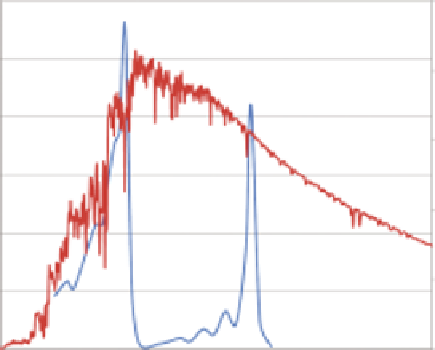Environmental Engineering Reference
In-Depth Information
2.50E+03
120,000
100,000
2.00E+03
80,000
1.50E+03
60,000
1.00E+03
40,000
5.00E+02
20,000
0
200
100
0.00E+00
300
400
500
600
700
800
900
Wavelength (nm)
FIGURE 15.14
Absorbance spectra for chlorophyll versus solar energy on a mid-summer day.
pigments are often quantiied using extraction and either luorescence or spectrometry or by
in vivo
luorometry. For example, probes may be used for the bluish pigment phycocyanin, which gives the
Cyanobacteria their name, and/or the reddish pigment phycoerythrin, which gives the red algae
their common name.
15.3.1.1.4 Size and Shape
The size and shape of phytoplankton vary enormously, and for a section title in his limnology
textbook, Wetzel (2001) used “Small is Beautiful and Productive.” Since all phytoplankton live in
basically the same place, the photic zone of the water column, their size and shape may relect their
various adaptations to that environment.
One consequence of living in the photic zone is that any object will tend to settle out of it. Most
phytoplankton are negatively buoyant, so they sink. So, logical questions may be why are they nega-
tively buoyant and how can they persist? Vogel (2004) suggested that negative buoyancy may be an
evolutionary adaptation to prevent phytoplankton from being trapped by surface tension. Regardless
of why they sink, the distribution of phytoplankton is impacted by the rate of settling.
For quiescent waters, factors impacting the sinking velocity can be illustrated using Stoke's law:
(
)
2
′
−
2
gr
ρρ
µ
v
s
=
9
R
where
v
s
is the sinking velocity
g
is the gravitational acceleration
r
is the radius of the sinking spherical particle
ρ′ is the density of the sinking particle
μ is the viscosity of the luid
R
is a form factor correction (with values of 0-1) for a shape other than spherical.
So, the sinking velocity is inversely proportional to the viscosity of the luid, directly propor-
tional to the difference in density with the luid, and directly proportional to the square of the radius.
Stoke's law was developed for the settling of a perfect sphere, where settling is independent from

Search WWH ::

Custom Search